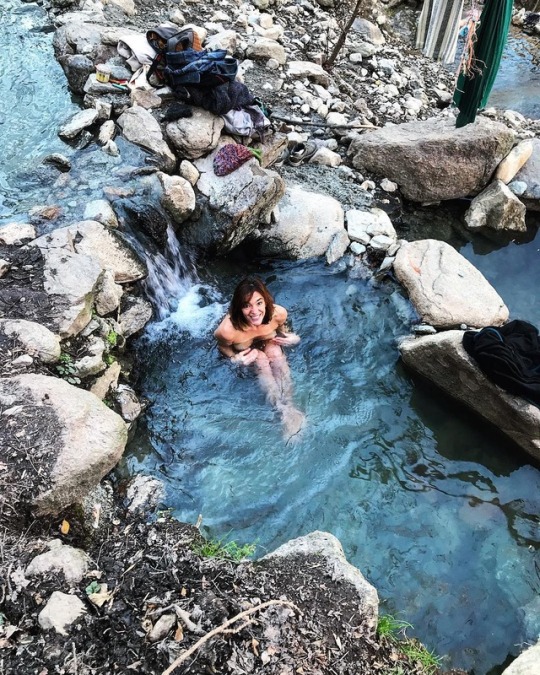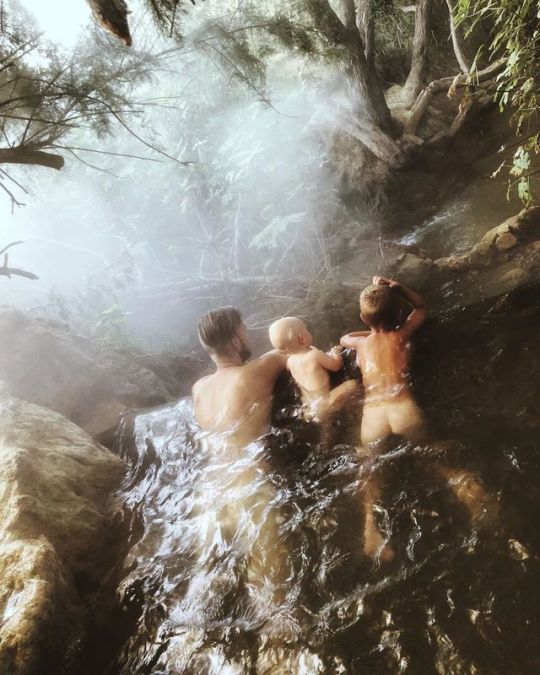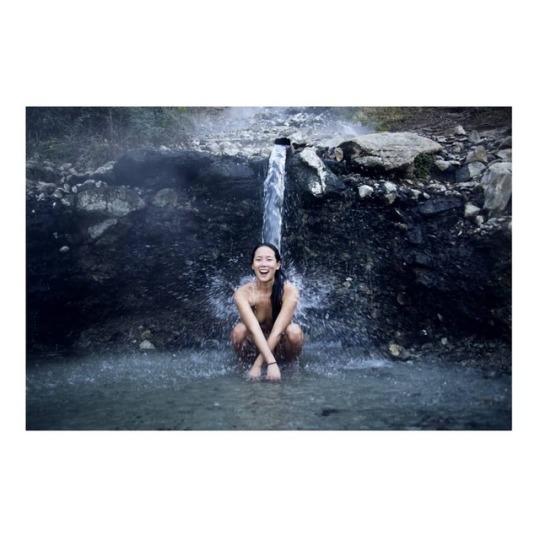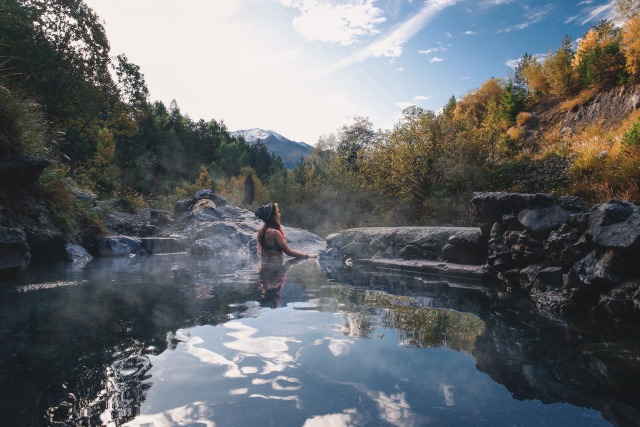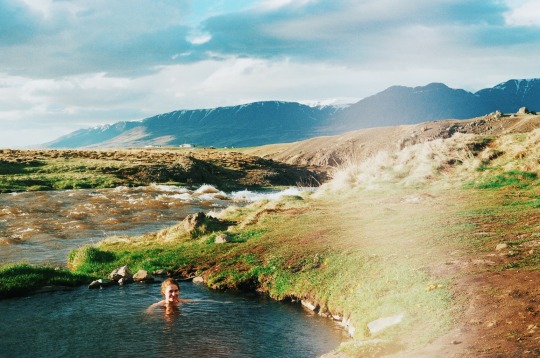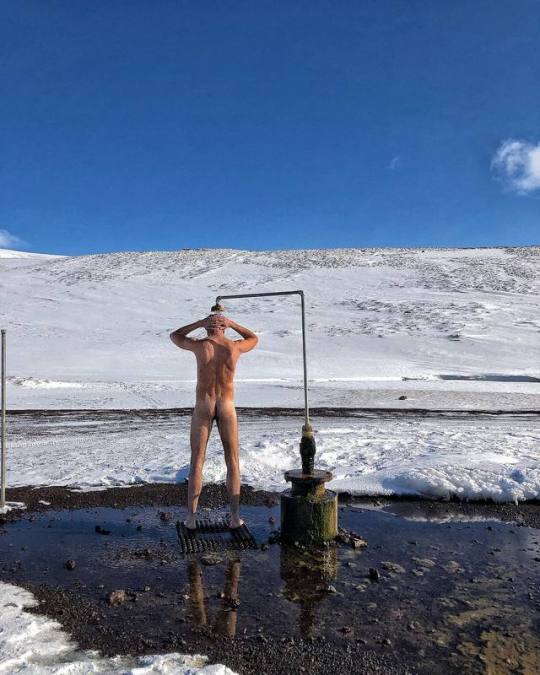jennyandthejungle at Prats Balaguer, Languedoc (France):
Our secret spot ❄️💦 .Winter is upon us. Nearly.
.
.
.
#nature_brilliance#pyrenees#artofvisuals#welivetoexplore#natureaddict
#outdoors#mountainstories#earth_deluxe#instanaturelover#nature_prefection
#allnatureshots#hotsprings#naturelovers#wanderlust#liveauthentic#thecreative
#livefolk#mountainlove#gottalove_a_#instamountain#nature_perfection
#mountainlion#mountains#bainssaintthomas
What's topical in Europe's soaking world?
The Guardian (Sep. 26) asked it's readers for tips on Europe's spa's, baths and sauna's:
'Winning tip: Free and easy, FinlandTbilisi's sulphur thermal baths gets tipped, as does Tuscany's Saturnia soak. So does Ax les Thermes (Southwest France) and Dona Beija (Sao Miguel, Azores); as well as many other hot spring mentioned in the readers comments.
Armed only with a towel, a bundle of firewood (in case stocks had run out), a pack of sausages and some spring water (to drink and throw on the stove), I went one evening with my Swedish friends to the tiny, do-it-yourself Sompasauna. Built by volunteers, it’s 15 minutes’ walk from the Kalasatama metro in Sompasaari, Helsinki. Free to use, it’s open day and night all year round and kept spotless. There are no lockers, showers or staff, so it’s real back to nature stuff. After enjoying the sauna, we went for a swim in the Gulf of Finland, then had a convivial barbecue with other visitors'.
betybut555 at Termas De Yesa (Navarra, Spain)
A slightly older article from GoNomad though google says November 10, so let's stick with that. It's about coming to terms with foreign habits. Or foreigners getting used to local culture:
'As a Canadian, I’m known, culturally, for living a bit of the frontier life, exploratory, open-minded, opposed to the strictures of tradition and convention, and perhaps just a little bit crass.It seems though, despite bringing Canada into it, it's a more personal take.
However, going to the nude spas in Germany, naked as the majority are, I was surprised to add to that list my own uniquely un-Canadian descriptor, “uptight.”
michael_loveria showing off culture appropriateness at Austria's Bad Gastein-Felsentherme:
Blackbird FLY! #badgastein #blackbird #tattoo #ass #naked #nude #mountain #austria #wellness #sauna #dayoff #roadtrip #livefree #freeAn article in the Guardian (Oct. 13) on the World Aufguss Championship held in the Netherlands:
'It is the final day of the week-long world aufguss championships at Thermen Berendonck, a stunning sauna complex in Wijchen, near Nijmegen, where nearly 100 contenders and 11 European countries compete for medals. Surveying the room, I see friends chatting, couples clasping hands. Some banter and clap. No one avoids eye contact or stares at their feet. This could be any spirited theatre crowd, were it not for the nudity.A great article, don't forget the comments section: as (nearly) always with the Guardian, they are often more entertaining than the article itself.
...
Britain is not a competing country here and while aufguss might inspire snickering among some buttoned-up Brits, it is part of a booming European industry that intersects wellness with the arts. According to Martijn Vanhoorelbeke, a juror at the aufguss and three-times former Belgian champion, the benefits include not just the detoxifying effects of a sauna but emotional catharsis, too. He regards it as a “total experience” of the senses: “Aufguss does what other kinds of theatre cannot do with the smells [of the oils], the sounds and sights, the feeling of the heat as well as the emotional drama of the story and the effect of all of those things combined.”
We are more vulnerable when we are more exposed, he adds, and so the experience not just bring out physical toxins but “emotions rise up, too.”
merilyten at Santa Fé (Andalucia, Spain):
Vedelesime terve esmaspäevase päeva “SPAs”. Kui pühapäeval oli õhutemperatuur liiga kuum, siis esmaspäeval läks õhk nii külmaks, et kuum vesi oli ainus koht kuhu põgeneda. Aga ega head asja liiga palju ka ei saa ning pidime hüvasti jätma oma lemmik kohaga..Warm water is the best place to escape when the weather gets cold. But now it’s time to move on..
#minueurotripp#thermalsprings#hotsprings#nature#naturespa#spa#purenature
#naturefamily#lossipoisid#jungleboys#jungle
Let's look at more depth of what's happening in each region.
Think GeoEnergy reports (Oct. 20) on developments in eastern Greece:
'As reported from Greece, cheap geothermal energy and heating is coming to Alexandroupolis, a seaside municipality in the east of the country. The green light has been given for the groundbreaking work on this district heating project. After months of litigation, work will begin next and be completed in 18 months. The project implemented by the Municipality of Alexandroupolis has a budget of EUR 6.2 million (USD 6.8m) and is considered pioneering for the whole of Greece, as it gives local communities great development opportunities, while also having positive effects on residents who can afford cheap heating'.Hopefully it doesn't affect the local hot spring.
Again Think GeoEnergy (a great source of never ending info on geothermal development; alas quite a bit of company news). It looks (Sep. 11) at Bavaria's Erding Therme. Citing and translating a local source:
'For now more than 20 years STEAG New Energies GmbH Erding has supplied the city of Erding with geothermal energy from resources at a depth of 2,350 meters. Today, about one fifth of the total heat demand of Erding can be covered by climate-friendly geothermal energy. The article published yesterday, looks behind the scenes of the geothermal heating plant Erding 2.
The history of Erdinger Erdwärmeversorgung began in 1983, when oil firm Texaco drilled for oil. With heavy equipment the company drilled to ab depth of 2,359 meters into the earth’s surface. No oil was found, but 65 degrees Celsius hot thermal water. The oil company had no interest whatsoever in the water, which resulted in the city and the the larger municipality founding a joint venture to use the “hot gold”, as they call it in 1989.
...
Plans were initiated for the local thermal bath Therme Erding in 1994, which then opened in 1999. The bath was planned as there was no second well planned at the time, through which the cooled down water could have been returned into the reservoir below. At the time, it was more economical to treat the thermal water and use it in a spa, almost incidentally a recreational “temple” was created that has made Erding famous around the world. The spa is today by far the largest customer of the joint venture for thermal water and STEAG for geothermal heating.
...
With the geothermal heating plants, the city saves almost two-thirds of carbon dioxide (CO2) and nitrogen dioxide (NO2) emissions each year ...'.
kaerntnerkrone
Das Maibachl rinnt! Wer war schon baden? ☀️💦.#kaerntnerkrone#krone#kronenzeitung#kaernten#carinthia#villach#villachfeeling
#maibach#maibachl#ausflug#ausflugstipps#kampadanes#nasvetzaizlet
#placetovisit#escapesnaps#wetter#winter#winterinaustria#winter2019
#outdoors#nature#naturesbeauty#scenery#landscape#beautiful
Where are we now? Umm, let's continue with France.
A recent find, Le Trou de Madame. Not far from Dax in France's southwest near the banks of the river Adour, it used to be a thriving thermal establishment. Apparently due to waning interest nothing has been happened in the last 50 years or so. My source further reveals:
This website adds:A recent find, Le Trou de Madame. Not far from Dax in France's southwest near the banks of the river Adour, it used to be a thriving thermal establishment. Apparently due to waning interest nothing has been happened in the last 50 years or so. My source further reveals:
'Si l'on prétend que les eaux et boues thermales de Préchacq étaient connues dès l'Antiquité pour leur vertus curatives, les bains ne consistaient, jusqu'au début du XVIIIe siècle, qu'en quelques sources chaudes s'épanchant dans de grands trous remplis d'eau boueuse au milieu d'une belle forêt de chênes des bords de l'Adour.
'L'odeur présente de cette source sulfureuse est très forte,et, assez incommodante ( odeur d’œufs pourris ). L'eau présente est d'environ 30 °C'.A further find, a website for springs in the area of Les Landes, southwest France; most cool though.
yogaconlilin at Prats Balaguer:
Allò que fa riure als ulls és bo.Del finde 22 i 23 desembre, acampant a la fresca fent de la lluna el nostre sostre.📸 @queralt_aloy gràcies per aquests moments!!Bliss
Sadly, Lamiacittanews (Sep. 19) notes that September 28 will be celebrated as the fifth anniversary of the Bullicame thermal spring running dry:
'Si invita tutta la cittadinanza a partecipare alla mesta cerimonia, recandosi al capezzale della callara, tenuta in vita da una flebo di accanimento terapeutico, che proviene dal pozzo S. Valentino. Non fiori, ma insistenze e solleciti su chi deve provvedere a sistemare e a fare sistemare il danno provocato'.
More info on the situation (Lamiacitta, Aug. 2; Lamiacitta, Aug. 30) of Bullicame.
Lamiacitta (Sep. 22) takes a looks at nearby Carletti
A lot of Sicilian soaks from soakersforum by benjaminstarr:'... went for a walk at the Carletti Spa on Strada Terme, where thermalism is free, as it always has been for our fathers. I must say that there were many people. Some soak in the tanks near the spring, and others who were blissfully sunbathing. The trash bins were all emptied, and there was a clear and crystalline air, like only Viterbo and a few other places in Italy, can offer'.
- Lipari's Terme di San Calogero (He also mentions steam caves)
- Segesta
- Vulcano
- Sclafani Bagni (with photo below):
Gonews.it (Oct. 14) introduces us to a novelty:
'Hundreds of people, originating from the geothermal area or coming from other areas of Tuscany, took part in the twelfth edition of the geothermal Trekking along the beautiful path of natural manifestations "Geothermal and Steam" which leads from the Fumarole Park of Sasso Pisano, in the municipal territory of Castelnuovo Val di Cecina, at the Biancane Park in Monterotondo Marittimo, between the provinces of Pisa and Grosseto.
...The participants had the opportunity to visit the Enel Green Power geothermal plant "Sasso 2", in Sasso Pisano, and the archaeological excavations of the Etruscan Roman Baths of Bagnone'.
Our main incentive for spending a week in the Stelvio National Park amongst the shaded valleys and snow-dusted peaks were the thermal waters of the Pozza di Leonardo DaVinci.Morning and night, we would skirt the narrow concrete bridges and cliffs above the Adda river into the depths of the valley. Opposite the old crumbling Stelvio Pass road we abandoned our clothes to the rocks and sunk into the clear, warm waters beneath the steam.It felt good to be back in a hot spring after so many months without, our skin softened by the minerals and our aches and pains soothed by the heat. It was just as spectacular to bathe beneath the stars as it was with Alpine views, the pool warming us to our very bones.Our time spent in the National Park gave us a chance to explore, to experience the area in-depth, to hike its narrow crumbling paths and shop at the local weekend market. We experienced many facets of Italian Alpine life, the food, the culture and the conversation, and revelled in the harsh, unpredictable landscape.The nights were cold, and the days not much warmer, as we waited for the snow atop the pass to clear so we could continue on our journey…Strength
Let's head for central Europe. Starting with Slovakia.
Think GeoEnergy (Sep. 20) has a similar story to the one above on Erding:
'While not being successful in exploration for oil back in the 1960s, the wells drilled then actually turned out to change the village of Podhájske in Slovakia. Finding geothermal water then, was the foundation for a large thermal spa park and greenhouses.
...
The village Podhajska is situated approximately 90 km east of Bratislava in northeast part of Danube basin. The Podhájske Thermal Park features 10 pools with water temperature between 26 and 38°C. The well also provides heat to greenhouses nearby, growing flowers and tomatoes'.
Neobsidimdoma (Dec. 19, last year) with the above picture and the following report. Translated:
'The pre-Christmas season peaks and stress waves are at maximum. You know it: I don't have gifts yet…, you have to clean at home…, you don't recognize the baking dust from the shelf dust…, the gingerbreads don't soften… but simply: stress, panic, nervousness, migraine I decided to reset my head this year I have a great trip to Liptov. Yes, it's cold outside, the tourist season is also freezing, many attractions are closed, but it doesn't matter if you choose such a beautiful area as Liptov. I chose Pension Mara in Liptovsky Trnovec as the base camp and it was a great choice!
...
This water has 20 degrees and has proven healing effects. Since the outside air temperature was below freezing, the water sensation temperature was higher and I endured the recommended 20 minutes. In the summer months, this hot spring is very popular and often visitors have to wait in rows to bathe. The home people told me that it is best to come at night and enjoy the bath by watching the stars. I think I will certainly try it. There is also a drinking mineral spring Teplica near Kade, I recommend to strengthen after the bath with this medicinal water.
...
Kalameny village is located only 2 kilometers from Lúčok and the spring will be directed by the locals. This spring is much warmer than the spring in Liptovský Ján, the water is approximately 30 degrees. So in winter the feeling of a bath is really warm and you won't want to get out of the water'.
A more older article (Feb. 8, 2014), but for me a more recent find. A wild hot spring in Hungary, well sort of. Unique? The discharge of the delicate Heviz hot spring is released into a local stream, which is free to use. Though the article focuses on canoeing in winter. The link to exact location with google reviews including soaking reports.
Travel.usnews (recent, apparently):
'A soak in a thermal bath is a quintessential Budapest experience. (It hasn't cultivated a reputation as the "City of Spas" for nothing.) These baths, or fürdok in Hungarian, are heated by natural thermal springs and usually include on-site massage services, as well as steam rooms.
With more than 100 thermal springs, the various baths around the city cater to different tastes – from relaxation to cures for illness – and some transform into pulsating dance clubs at night, so if you're bathing with your family, you might want to do so during the daylight hours'.
m_a_s_p_i at Srpske Toplice, Republica Srpska, Bosnia:
Wherever you go, no matter what the weather, always bring your own sunshine. #nature #hiking #hotspring #teplypramen #musibyt #withfriends #vodactvojespatny #krizujemebalkan #krizujememapu #dnescestujem
Health
Over to Spain.
Ynetnews (Oct. 19) presents an article on the hot springs of Ourense (Galacia) and it's Jewish heritage. It basically revolves around the author's visit to Termatalia (Sep. 19 and 20):
Over to Spain.
Ynetnews (Oct. 19) presents an article on the hot springs of Ourense (Galacia) and it's Jewish heritage. It basically revolves around the author's visit to Termatalia (Sep. 19 and 20):
'Ourense has also cleverly leveraged its thermal heritage to become the global headquarters of Termatalia, a non-profit organization whose name derives from the Spanish terms Termalismo (thermalism) and Talassoterapia -- thalassotherapy, the therapeutic use of seawater. Termatalia has grown from a small regional organization in 1999 into an international organization encompassing much of Europe and Latin America'.
elena_ni_ta at the natural springs of Prexigueiro, not too far from Ourense:Encontré a una meiga en el río y me enamore de ella. De su sensual contoneo a la hora de andar, de los susurros al oído de los mantras al cantar, del olor de su cuerpo y la estela que deja al caminar, de su sonrisa, de su sabiduría y de su magia.Gracias amiga, por enseñarme algo tan bonito💜#termasgallegas #termasderibadavia #ribadavia #prexigueiro #ourense #galicia #naturaleza #meiga #magia #contacto #vacaciones #hollidays #remansodepaz #picoftheday
Then some late news from Iceland.
Famous activist (who uses her body to draw attention (or is it the other way round?)) Marisa Papen has a new calendar on the shelf for 2020 with photo's from Iceland (notably as below Hrunalaug hot spring). She hopes to draw attention to plastic soup:
Famous activist (who uses her body to draw attention (or is it the other way round?)) Marisa Papen has a new calendar on the shelf for 2020 with photo's from Iceland (notably as below Hrunalaug hot spring). She hopes to draw attention to plastic soup:
A Calendar-concept that aims for a healthy future of our planet.
Rough Guides (Sep. 20) finally, has an updated Top 10 soaks on Iceland. It's intro:
'An outdoor soak is an essential part of the Icelandic experience – a surreal way to spend a dark winter's day, or to unkink those muscles after a long day's hiking.In fact, the Icelandic tradition of bathing outdoors in volcanically heated pools dates right back to Viking times. A few of these old pools survive today – often sited in spectacular locations – whilst almost all settlements, however tiny, have installed geothermally heated swimming pools with accompanying hot tubs'.
Nelitko at Fosslaug (I think)
